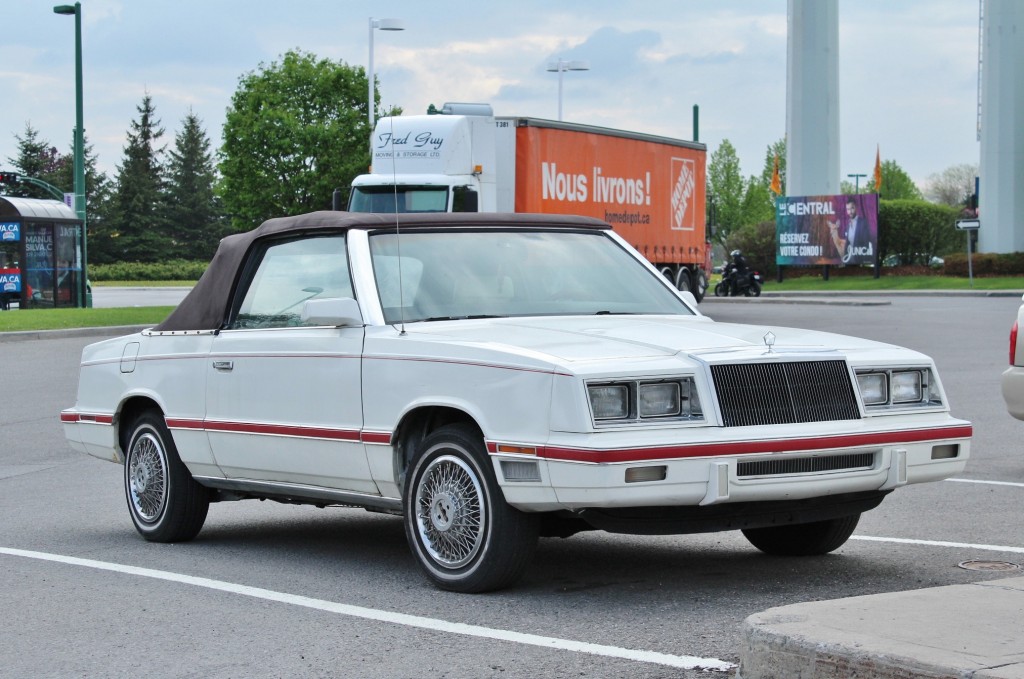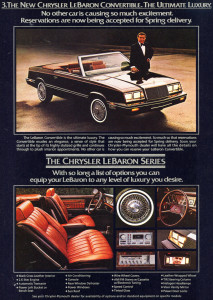It was, and still is, a status symbol born of 1980s America.
The Chrysler LeBaron convertible. Loved by many (especially Lee Iacocca and Jon Voight*), it was the first spin-off of the 1981 K-car architecture, and brought top-down motoring back to U.S. shores.
*debatable
Sadly, you don’t see many of these soft-tops plying the roadways anymore.
This 1982-83 example ditched the Town & Country’s fake wood veneer in favour of some sporty red pinstripes. All in all, it’s not in bad shape, though spots of rust are forming and the trim – like that of many old models – is starting to become misaligned.
While the LeBaron name had been used on and off by Chrysler for some time, it is these 1980s front-wheel-drive compacts that people most associate with the name.
Hot on the heels of the bankruptcy-busting 1981 Dodge Aries/Plymouth Reliant twins, Chrysler’s 1982 introduction of the LeBaron sedan, coupe, wagon and convertible helped squeeze as many products as possible from an existing platform (in order to put the company’s finances firmly in the black).
Joined by its stablemate, the Dodge 400, the new ‘Super-K’ aimed to bring luxury to the still-novel domain of front-wheel-drive American vehicles.
At the time, the U.S. was still struggling from the effects of a recession and high gas prices brought on by the Iranian Revolution. Value for money was everything, which explains why Americans flocked to buy the cheap-but-roomy Aries and Reliant starting on Day 1.
In order to capitalize on the success of the first year K-cars and solidify the company’s comeback, Chrysler Corporation released a now-famous television commercial starring chairman/saviour Lee Iacocca.
https://www.youtube.com/watch?v=v6nmCFTmPnE
Iacocca enticed potential buyers with an old-fashioned sales pitch that culminated in the iconic line, “If you can find a better car, buy it.”
Mechanically, the early K-derived LeBarons harnessed the same hardware as their lesser brethren.
A carbureted 2.2-litre four-cylinder made 84 horsepower and 111 lb-ft of torque, mated to a 3-speed Torqueflight automatic transmission or less-common 4-speed manual.
Optional was the 2.6-litre four borrowed from the Mitsubishi Astron. Also carbureted, this hefty 4-banger made 114 hp and 146 lb-ft, and served as the K-class upgrade engine until the Chrysler-made 2.5-litre came on board in 1986.
Starting in 1984, LeBaron owners could outfit their ride with a turbo version of the 2.2 and finally enjoy top-end performance (the stock engine was tuned for low-end torque, but ran out of steam fast).
Despite not being designed for it, the 2.2 proved to be very adaptable – several increasingly powerful versions of the turbo 2.2 were built before the engine ceased production in the mid-1990s.
While their numbers dwindle each year, we can find comfort in the fact that LeBaron convertibles will always live on through their many movie and TV appearances.
‘Planes, Trains, and Automobiles’ (1987) features many memorable road trip scenes in a LeBaron Town & Country, while a 1994 episode of Seinfeld immortalized the same model as the too-good-to-be-true ‘Jon Voight car’.
Long live the Jon Voight car.


